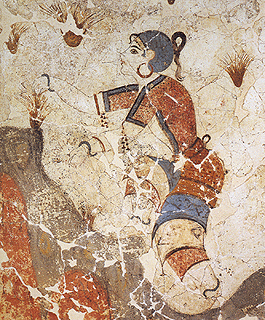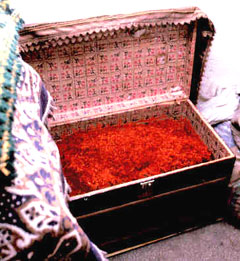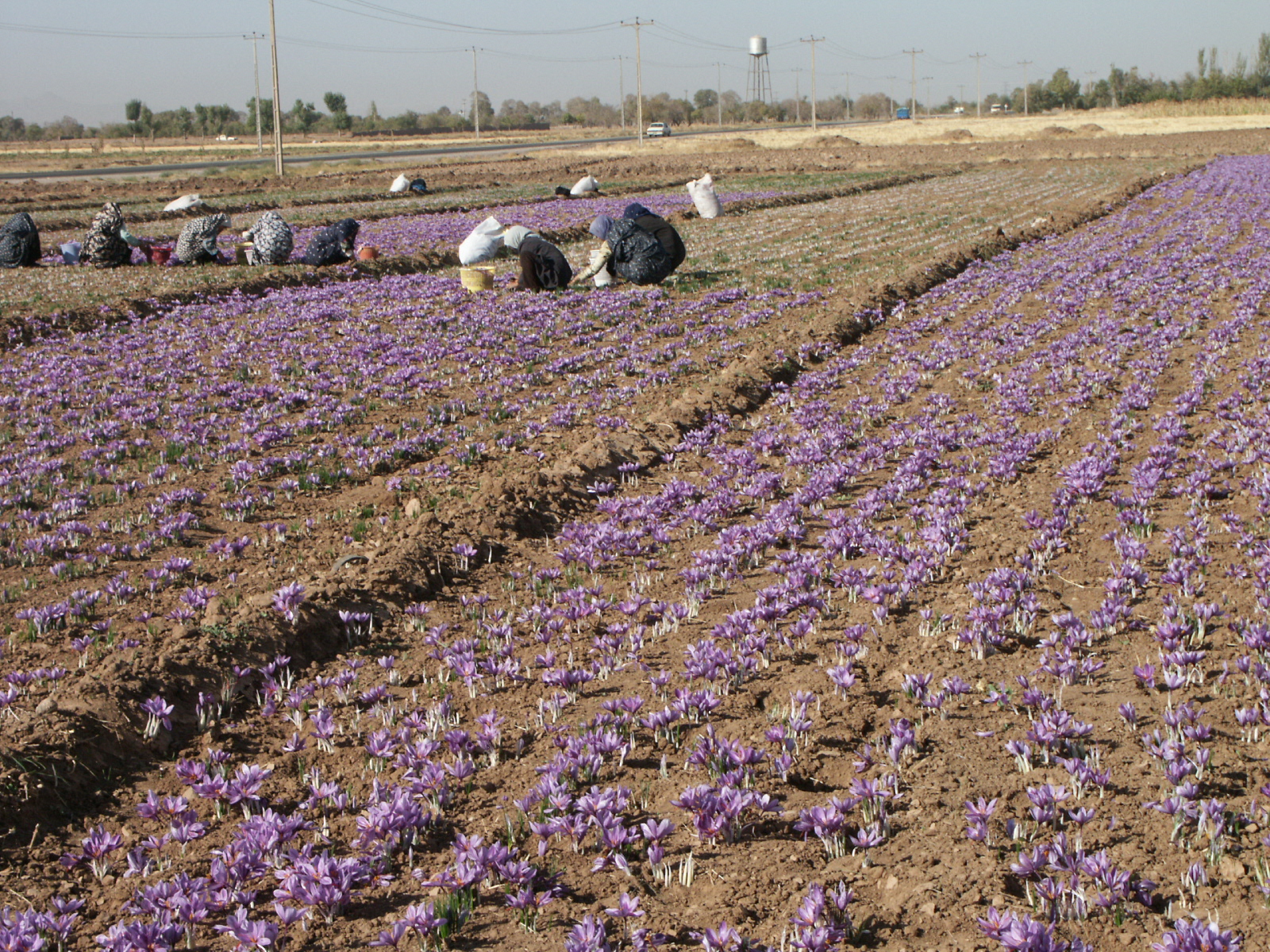| HOME | Links | More news | Gallery | Site Map | Search in Google | Search in CrocusBank | Contact us |
|
|
||||
|
| Saffron must be considered as an European crop of added value deserving scientific interest for various reasons | |
1) Its origin and historical background. The origin of saffron crop is uncertain. C. sativus is cultivated for its spice for at least 3,500 years in Egypt and Middle East . The name Crocus finds its origins in the Greek word krokos, saffron, which in turn derives from the Semitic word karkom, one of the oldest names for this plant. Some archaeological and historical studies indicate that domestication of saffron dates back to 2,000–1500 years BC. This is derived from documents reproducing the plant or showing people collecting the crop. However the sites where the first saffron plants appeared differ according to the opinion of various authors. Vavilov placed saffron into IV plant origin centre of Middle East (Minor Asia, Transcaucasia, and Turkestan); whereas more recent contributions indicate that the process of saffron domestication has to be identified on Crete during the Late Bronze Age. Historical records detail the use of saffron date to ancient Egypt, Greece and Rome, where it was used as a medicinal plant, as a dye, in perfume, and as a spice and colorant for culinary purpose. Saffron use reached its highest point in the Iberian Peninsula by the Arabs. During the Middle Age saffron crop was extended for rest of Europe due to the Crusaders, and was settled in Switzerland, France and Italy, reaching Great Britain in the 14th century. Towards the east, saffron crop was preserved for diverse civilizations in the current territories of Iran, Azerbaijan and Kashmir. Saffron was firstly exported to China in 13th century as healthy food, and again in 16th century as medicine. It reached Japan at the beginning of 17th century. Since then, Japanese people have used saffron almost exclusively as health product. |
 |
2) Tradition and quality. Besides the European countries only produce a scarce 3% of world saffron market, the quality and the prestige in the marker still correspond to the European brands. La Mancha saffron has been generally the highest prized, and “La Mancha” region was during centuries the world biggest producer. Currently the Spanish manufacturers and dealers control 70% of the world's saffron market.
The European saffron under Protected Geographical Indication (PGI) status are: "Krokos Kozanis"(EC Reg. 378/1999), Greece (Kozani) Azafrán de la Mancha " (EC Reg. 464/2001), Spain (La Mancha) |
 |
| France have two associations of saffron farmers that pursue the same PGI status:
"Les safraniers du Gâtinais" in 1987 Les Safraniers du Quercy” in 1999 As mentioned saffron crop is in severe danger of extinction in Europe at the present time. What used to be the “King of Spices” suffers from a worldwide devaluation. Amazingly, very little has been done to protect the saffron crop in Europe . Recently, in 2002, the Regional Government of Castilla-La Mancha (Spain) spent 150,000 euros/year in direct financial support to saffron producers, ranging between 1,200-1,800 euros/ha with a maximum of 3,000 euros per farmer. Anyhow, the genetic erosion has been intense and now it now it is urgent to protect what remains of the European saffron germplasm. On the other hand, saffron is considerate to be the highest priced spice in the world. In fact, saffron is one of the most valuable food products (the red gold), and its highest quality is still associated to the European brands. European production has the added value of prestige and cultural significance of the product (gastronomy, history, art). |
|
3. Food-safety. Consumers are confused with the differences in quality between saffron of different origins and the subsequent fluctuation of prices. The quality of saffron is certified in the international trade market following the ISO 3632 Normative since 1993. The most important parameter is colouring strength, calculated from UV-Vis measurements at 440 nm in aqueous extracts of this spice. Such measurements are related to the total carotenoid content. This regulation is currently under controversy since leave aside the most important organoleptic properties of saffron (odour, flavour) and does not prevent fraud. Saffron commands a rather high value in the international spice trade that results in its frequent adulteration by artificial colorants and by mixing genuine stigmas of saffron flower with other parts of plants (e.g. some species of grass) artificially coloured. Molecular tools will be ideal for checking purity of product, even after processing, act as markers for adulteration (either with dyes or with other plant species). |
 |
4. Alternative Uses. Saffron is mostly used as spice and food colorant and, less extensively, as a textile dye or perfume. However, due to its analgesic and sedative properties, traditional Eurasian herbal medicines have used saffron for the treatment of numerous diseases. Saffron has been indeed one of the oldest plants used as medicine (see the frescoes of Thera , Greece ). The renewed importance of saffron as nutraceutical is being sustained by an increasing number of evidences. Saffron has been claimed to have effects on senile dementia, retina-degeneration, immunomodulation, as well as antimicrobial, antidepressant, antitumour or cardiovascular protective properties. Although these effects required more pharmacological/nutraceutical trials and significantly additional scientific substation, we support the potential health application of this plant, with a profile similar to green-tea, ginseng, etc.
he application of the agroresource refining concept to the other parts of the saffron plant (style, petals, stamens, leaves, stem and corms) is actually underway in order to valorise all the organs of the plant. This saffron by-product valorisation is in agreement to the European Agricultural Policy that tries to encourage alternative uses for agricultural matters. Some of our research groups are focused in obtaining pharmaceutical, aromatic and dye products for health and cosmetic industries. |
 |
5. Sustainability. Saffron is a low water demanding plant well adapted to arid or semiarid lands; it has a low input of fertilizers (if any) and chemicals. Actually, saffron is still cultivated almost in the same manner for 3,000 years. This environmentally sound crop is one of the ancients of Europe . Its unique eco-physiology amongst many crops makes this plant appropriate for marginal soils, mainly but not exclusively in the Mediterranean area. The concept of a sustainable EU agriculture fits perfectly with the saffron crop (Koochecki, A. Acta Hort. 650: 175-182. 2004). Note that while the world's total annual saffron production is estimated at about 200 tons per year, Iran with more than 47,000 hectares of land under saffron cultivation is said to produce 80 percent of this total. India is the second producer. Any serious effort to create a bank germplasm in saffron would be enriched with the participation of researchers, agronomists or merchants from third-countries, simply because they must keep a significant amount of the global genetic variability present in saffron crop, together with a wide knowledge of its agronomy and uses. It must be strongly taken into account that having the support of putative commercially competitors, as occurs in this proposal, is highly valuable. Such trust is based on the environment generated in the 1st ISSBB, carried out in the University of Castilla-La Mancha (Albacete, Spain) on October, 2003 under the auspices of the ISHS, and the settlement of the Working Group M04 (Saffron Biology and Biotechnology) inside the section of Medicinal and Aromatic Plants of the ISHS. This meeting has a second step in the Second ISSBT carried out at the Ferdowsi University of Mashhad (Iran) last year (October 2006). |
 |
It is not an overstatement to say that this bank of germplasm extents its obvious European interest to a wider scale, and must be the basis of the World Saffron & Crocus Collection for everybody's use. |
|
The principle of “The conservation and sustainable use of genetic resources in agriculture are essential to the sustainable development of agricultural production and of rural areas” prompt the saffron germplasm main stakeholders in the European regions and third states around the world to joint a consortium involving crocus relatives to propose the CROCUSBANK project aiming to contribute to the Biodiversity Action Plan for Agriculture (Council Regulation (EC) No 870/2004) The CROCUSBANK project will contribute to the new Community programme on the conservation, characterisation, collection and utilisation of genetic resources in agriculture launched by the Commission. |
|